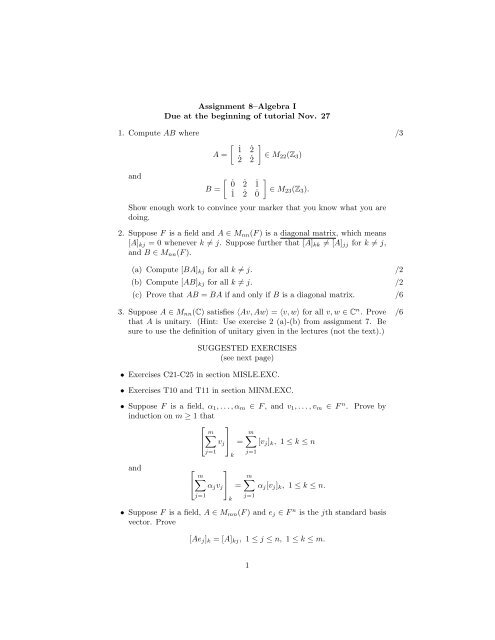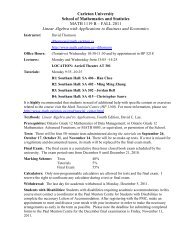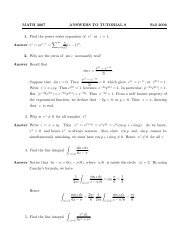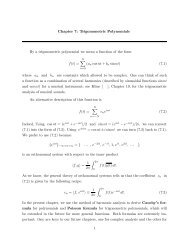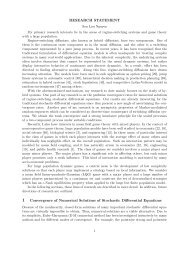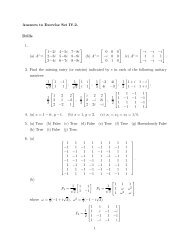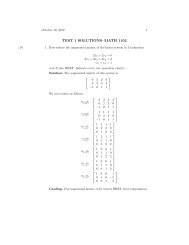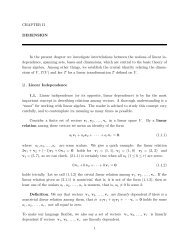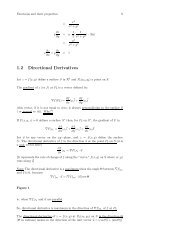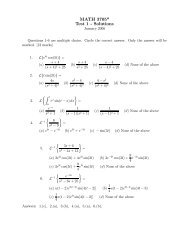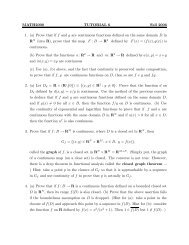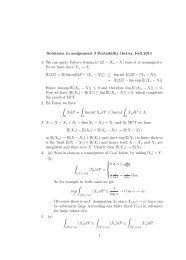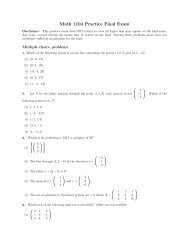Assignment 8–Algebra I Due at the beginning of tutorial Nov. 27 1 ...
Assignment 8–Algebra I Due at the beginning of tutorial Nov. 27 1 ...
Assignment 8–Algebra I Due at the beginning of tutorial Nov. 27 1 ...
You also want an ePaper? Increase the reach of your titles
YUMPU automatically turns print PDFs into web optimized ePapers that Google loves.
<strong>Assignment</strong> <strong>8–Algebra</strong> I<br />
<strong>Due</strong> <strong>at</strong> <strong>the</strong> <strong>beginning</strong> <strong>of</strong> <strong>tutorial</strong> <strong>Nov</strong>. <strong>27</strong><br />
1. Compute AB where /3<br />
<br />
˙1<br />
A =<br />
˙2<br />
˙2<br />
˙2<br />
<br />
∈ M22(Z3)<br />
and<br />
B =<br />
˙0 ˙2 ˙1<br />
˙1 ˙2 ˙0<br />
<br />
∈ M23(Z3).<br />
Show enough work to convince your marker th<strong>at</strong> you know wh<strong>at</strong> you are<br />
doing.<br />
2. Suppose F is a field and A ∈ Mnn(F ) is a diagonal m<strong>at</strong>rix, which means<br />
[A]kj = 0 whenever k = j. Suppose fur<strong>the</strong>r th<strong>at</strong> [A]kk = [A]jj for k = j,<br />
and B ∈ Mnn(F ).<br />
(a) Compute [BA]kj for all k = j. /2<br />
(b) Compute [AB]kj for all k = j. /2<br />
(c) Prove th<strong>at</strong> AB = BA if and only if B is a diagonal m<strong>at</strong>rix. /6<br />
3. Suppose A ∈ Mnn(C) s<strong>at</strong>isfies 〈Av, Aw〉 = 〈v, w〉 for all v, w ∈ C n . Prove /6<br />
th<strong>at</strong> A is unitary. (Hint: Use exercise 2 (a)-(b) from assignment 7. Be<br />
sure to use <strong>the</strong> definition <strong>of</strong> unitary given in <strong>the</strong> lectures (not <strong>the</strong> text).)<br />
SUGGESTED EXERCISES<br />
(see next page)<br />
• Exercises C21-C25 in section MISLE.EXC.<br />
• Exercises T10 and T11 in section MINM.EXC.<br />
• Suppose F is a field, α1, . . . , αm ∈ F , and v1, . . . , vm ∈ F n .<br />
induction on m ≥ 1 th<strong>at</strong><br />
Prove by<br />
⎡ ⎤<br />
m<br />
⎣ ⎦<br />
m<br />
= [vj]k, 1 ≤ k ≤ n<br />
and ⎡<br />
m<br />
⎣<br />
j=1<br />
j=1<br />
vj<br />
αjvj<br />
⎤<br />
⎦<br />
k<br />
k<br />
=<br />
j=1<br />
m<br />
αj[vj]k, 1 ≤ k ≤ n.<br />
j=1<br />
• Suppose F is a field, A ∈ Mmn(F ) and ej ∈ F n is <strong>the</strong> jth standard basis<br />
vector. Prove<br />
[Aej]k = [A]kj, 1 ≤ j ≤ n, 1 ≤ k ≤ m.<br />
1
• Suppose F is a field. We define a m<strong>at</strong>rix A ∈ Mnn(F ) to be upper-triangular<br />
if [A]kj = 0 for all 1 ≤ j < k ≤ n.<br />
1. Give an example <strong>of</strong> an upper-triangular m<strong>at</strong>rix.<br />
2. Suppose A, B ∈ Mnn(F ) are upper-triangular. Prove th<strong>at</strong> AB is<br />
upper-triangular.<br />
3. Suppose A ∈ Mnn(F ) is upper-triangular. Prove th<strong>at</strong> A m is uppertriangular<br />
by induction on m ≥ 1.<br />
4. Give a definition for a square m<strong>at</strong>rix to be lower-triangular. Do <strong>the</strong><br />
previous result remain true for lower-triangular m<strong>at</strong>rices?<br />
• Suppose A ∈ Mnn(C) and v, w ∈ C n . Prove th<strong>at</strong><br />
by using Theorem AIP.<br />
〈v, Aw〉 = 〈A ∗ v, w〉<br />
• Suppose A ∈ Mnn(C) is invertible. Prove th<strong>at</strong><br />
and<br />
A −1 = ( Ā)−1<br />
(A ∗ ) −1 = (A −1 ) ∗ .<br />
• Give examples <strong>of</strong> invertible m<strong>at</strong>rices A and B such th<strong>at</strong> A + B is not<br />
invertible.<br />
• Give examples <strong>of</strong> invertible m<strong>at</strong>rices A and B such th<strong>at</strong> A+B is invertible,<br />
but (A + B) −1 = A −1 + B −1 .<br />
• Give examples <strong>of</strong> non-zero m<strong>at</strong>rices A and B such th<strong>at</strong> AB is <strong>the</strong> zero<br />
m<strong>at</strong>rix.<br />
• Pick a m<strong>at</strong>rix in M22(Z5) and determine whe<strong>the</strong>r it is invertible or not. If<br />
it is invertible, compute its inverse. Repe<strong>at</strong> this exercise until comfortable.<br />
Try with Z7 in place <strong>of</strong> Z5.<br />
• Suppose {v1, . . . , vk} ⊂ C n is an orthonormal set and w ∈ span{v1, . . . , vk}.<br />
Prove th<strong>at</strong> w = k<br />
j=1 〈w, vj〉vj. This gives us a simple way <strong>of</strong> computing<br />
a linear combin<strong>at</strong>ion expressing w!<br />
• Suppose F is a field and A, B ∈ Mmn(F ). Prove th<strong>at</strong> A = B if and only if<br />
vA = vB for all row vectors v ∈ F m . (Hint: Imit<strong>at</strong>e Theorem EMMVP.<br />
For this exercise think <strong>of</strong> v as a 1 × m m<strong>at</strong>rix.)<br />
2


